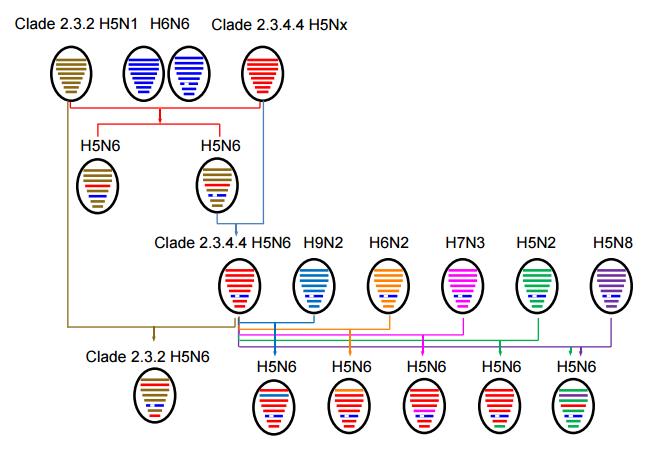Since H5N6 avian influenza virus first emerged in China in 2013, it has caused more than ten human deaths in China, which poses potential risks to human health. In order to further understand the evolutionary behavior of H5N6 prior to its emergence in humans, the research group led by Prof. CUI Jie from Wuhan Institute of Virology of the Chinese Academy of Sciences developed the studies on the evolution and emergence of H5N6 avian influenza virus in central China.
To better understand the complex molecular evolution and emergence of H5N6 at the local level, the researchers took surveys in the live poultry markets in Wugang prefecture in Hunan province in central China, and tried to reveal the diversity and genomic origins of H5N6 in birds. Notably, WHO reported and confirmed a human death caused by H5N6 in these live poultry markets on 21th November 2016 in this prefecture.
During 2014-2015, cloacal swabs and fecal samples from ducks, geese and environmental samples in the live poultry markets in Wugang prefecture were collected and screened for avian influenza virus by the researchers. Then the complete genomes of 175 H5N6 avian influenza viruse were sampled and sequenced. Their surveillance of H5N6 revealed that at least six types of reassortant H5N6 have circulated in that region, including a rare variant that possesses an HA gene derived from H5N1 clade 2.3.2 and a novel NP gene that has its origins with H7N3 viruses. As all currently reported H5N6 avian influenza viruses are members of H5N1 clade 2.3.4.4, their observation that one H5N6 virus seemingly carried an HA gene directly derived from H5N1 clade 2.3.2 is of importance. They suggest that a careful monitoring of H5N6 viruses in the live poultry markets and wild birds is evidently necessary to help prevent the virus from establishing itself in the human population.
In sum, the researchers have revealed a complex pattern of evolution and emergence of H5N6 in a single locality in central China over a two-year period. The results have been published in Journal of Virology entitled "Molecular Evolution and Emergence of H5N6 Avian Influenza Virus in Central China".
This work was supported by funding from the National Key Research and Development Program and the CAS Program.

Genesis of the H5N6 avian influenza virus. Image by CUI Jie
Contact:
CUI Jie
E-mail: jiecui@wh.iov.cn
CAS Key Laboratory of Special Pathogens and Biosafety, Center for Emerging Infectious Diseases, Wuhan Institute of Virology, Chinese Academy of Sciences, Wuhan 430071, China. (http://english.whiov.cas.cn/)